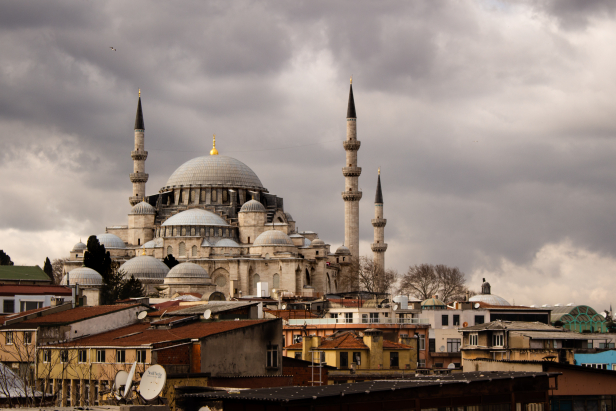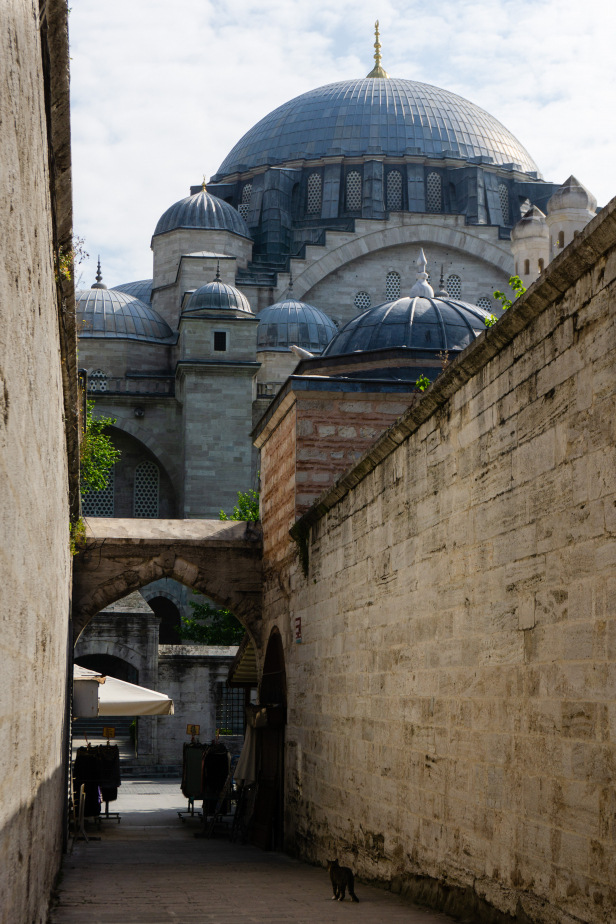Süleymaniye Mosque Complex
/ By Josh
Commanding a magnificent view of the great city of Istanbul, Süleymaniye Mosque is a model of the Ottoman mosque perfected. The largest Ottoman mosque in Istanbul and certainly one of the most beautiful, Süleymaniye is considered by many locals to be Istanbul’s greatest mosque. With a massive complex of beautiful dome capped buildings, park-like atmosphere, and unparalleled views, its one of Istanbul’s top sights.

The mosque and its vast complex were commissioned in the mid 1500’s by Sultan Süleyman the Magnificent (or “the Lawgiver” in Turkish), the longest ruling sultan in the Ottoman Empire. Under Sultan Süleyman the Ottoman Empire reached its incredible apex in power and culture and Süleymaniye Mosque is a perfect example of this power and learning. The mosque, like so many of the Ottoman’s greatest buildings, was built by court architect (Mimar) Sinan, whose tomb is nearby.
Subscribe to The Art of Wayfaring
Why Visit?
Süleymaniye Mosque
Süleymaniye Camii
Cost: Free
Completed in 1557, Süleymaniye Mosque was built with architect Sinan’s vision for a grander mosque than the Şehzade Mosque that he had just completed. Süleymaniye Mosque was built significantly larger than Şehzade Mosque and with a much simpler level of detail; an overall style that would set the tone for the future of Ottoman architecture for the next few centuries.

The mosque building is fronted by a spacious courtyard which offers the best view of the beautiful symmetry of the various domes, arches, and calligraphy. While most mosques would have a fountain for ablutions in the courtyard Süleymaniye Mosque has fountains along the outside walls which keeps the view of the grand entrance open.
The interior of the mosque is full of calligraphy and flowing patterns painted on the plastered dome. The Mihrab (niche at the front of the mosque denoting the direction of prayer and Mecca) is made of finely carved marble and surrounded by ornate blue tiles and stained glass windows.

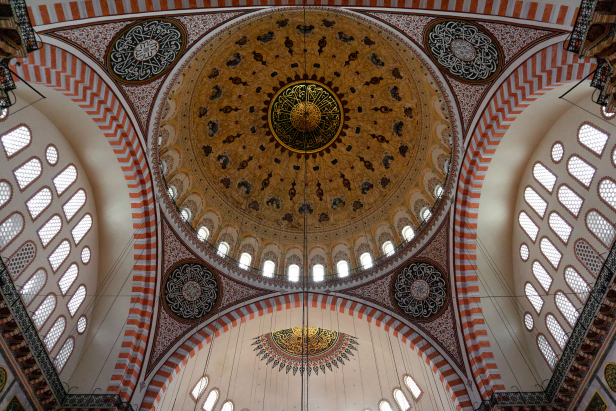
At the peak of the 50m tall dome, written on the keystone, is a Qur’anic passage (35:41) which reads “Indeed, Allah holds the heavens and the earth lest they cease. And if they should cease no one could hold them after Him. Indeed he is forebearing and forgiving.” The passage being written on the keystone ties together the tradition of the dome being a symbol for heaven and the fact that Allah holds the heavens and earth together like the keystone itself.
The Tombs of Sultan Süleyman and Hürrem
Süleymaniye ve Hurrem Sultan Türbeleri
Cost: Free
Next to the mosque is a small graveyard where the mausoleums of Süleyman the Magnificent and his favorite wife Hurrem Sultan. The story of the relationship between Sultan Süleyman and Hurrem is completely unique in the Ottoman history and is definitely ranked one of the most fascinating love stories of the Ottoman period. Hurrem, also known as Roxelana, was born in the modern Ukraine, captured and sold as a slave to the Ottomans where she became a concubine in the harem of Sultan Süleyman. She quickly became a favorite of the young sultan, rose in influence in the court, and even eventually became the lawful wife of Süleyman, breaking the centuries old tradition of Sultans not taking wives.
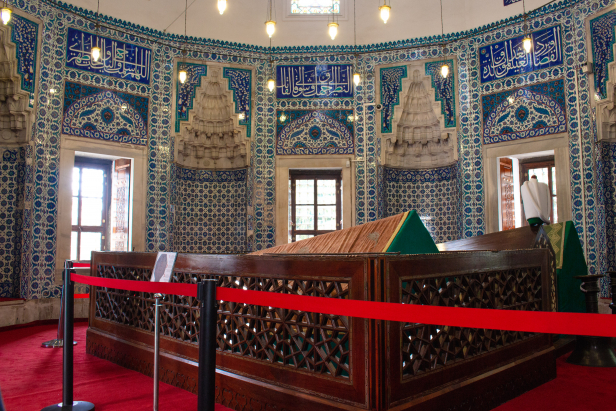
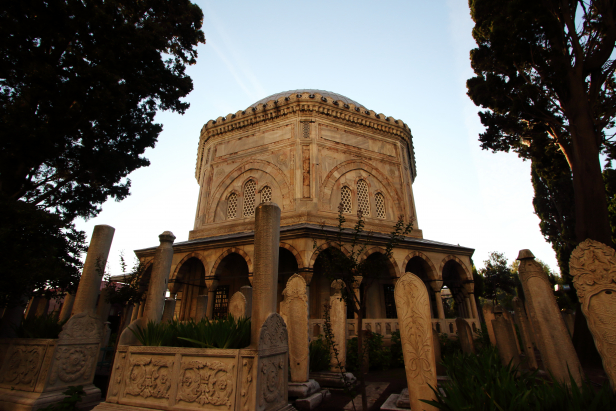
Befitting their relationship, Sultan Süleyman and Hurrem Sultan were buried in separate tombs side by side (exept for a few of the Sultans organs which were buried where he died in Hungary). Hurrem’s tomb is beautifully decorated with blue tiles while the tomb of Süleyman is larger though somewhat more austere.
Above the doorway into the tomb of Süleyman is a small black piece of stone (shaped like a triangle with a rounded top), this is a fragment of the Black Stone of the Kaaba. The Black Stone, (al-Hajar al-Aswad) is one of the most sacred objects in Islam and sits in the corner of the Kaaba (the large black cube in Mecca) where every year millions of Muslims make a pilgrimage to the sacred place.
The Social Complex
Külliye
Cost: Free
Süleymaniye is without a doubt one of the greatest examples of the Ottoman ideal of the mosque being a part of a much wider complex of learning and charities. The complex consisted of a Hamam, soup kitchens, a number of schools, lodges for Sufis, hospital, wrestling grounds, a medical school, and shop space to name a few. Today these are used as restaurants, wedding halls, cafes, schools, though many have been abandoned.

The Turkish Bath, Süleymaniye Hamamı, is still open and is a great opportunity to experience a unique part of classic Turkish culture in one of Istanbul’s most impressive bath houses.
From the open space on the north side of the mosque, looking out over the many domes belonging to the lower schools you can see Beyoğlu district with Galata Tower rising above the apartments.
The Tomb of Mimar Sinan
Mimar Sinan Kabri
Cost: Free
Just below Süleymaniye Mosque, on the north side of the complex, is a humble little tomb sitting in the narrow corner of a sharp intersection. The diminutive tomb belongs to Mimar Sinan, the architectural genius that designed Süleymaniye Mosque and over 300 other projects. The humble tomb stands in sharp contrast to his work only a short walk away and the tombs of the royals found there.
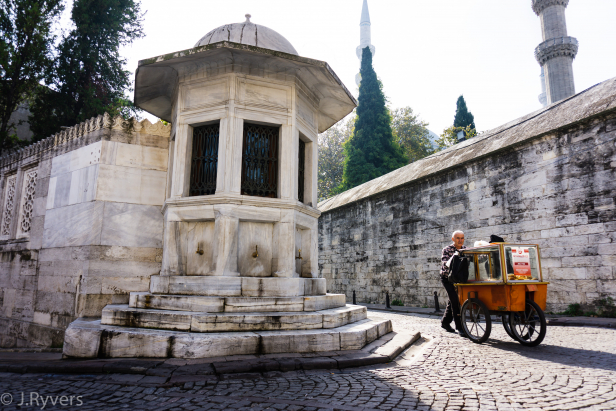
How To Get There
Hiking/Walking
As Süleymaniye Mosque is in the heart of ancient Istanbul’s most twisted and confusing streets we would recommend that you avoid taking busses and taxis and stick to your feet to try and get to Süleymaniye Mosque. Traffic in this area is terrible and its close proximity to the Grand Bazaar, Eminönü, and the Egyptian Spice Market make it easily accessible from any of these other tourist sites.
Public Transport
From Taksim/Istiklal
From the Taksim or Istiklal area of the city take the M2 Metro line south towards Yenikapı and get off at Vezneciler station. From here you can follow the signs along 16 Mart Şehitler street north for a few hundred metres to Süleymaniye Mosque.
From Eminönü or SultanAhmet
From Eminönü or SultanAhmet (Blue Mosque, Hagia Sophia etc.) your best bet is to take the T1 tramline to Laleli – Üniversite station. From here head north along Büyük Reşit Paşa street, cross Şehzadebaşı Street, and continue down 16 Mart Şehitler street to Süleymaniye Mosque.
Taxi
Depending on where you’re coming from getting to Süleymaniye Mosque by taxi may not be the best idea. The streets are narrow and congested and one way streets make for a bit of a nightmare. However, Süleymaniye Mosque is very central in the historic part of Istanbul so the fare will low if you’re coming from anywhere within that area.
Where To Stay
As Süleymaniye Mosque is right in the heart of historic and touristic Istanbul your accommodation options are almost endless. The immediate area is full of mid-range hotels with great access to all of the city’s main sights.
Other Tips
Make sure to walk up towards the Vezneciler metro stop and see the Valens Aqueducts, visit the Historic Vefa Bozacısı for a cup of boza, or visit Sehzadebaşı Mosque, the little brother of Süleymaniye Mosque.
Want to see more sights and destinations in Istanbul? Check out our full list of sights or The Istanbul Top 10.
Have any tips or info to add? Spot any mistakes? We’d love to hear about it.
